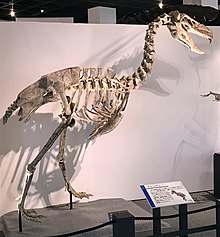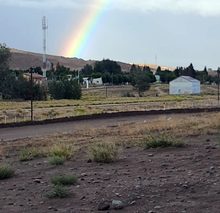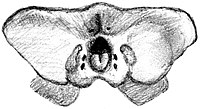Kelenken
| Kelenken | |
|---|---|

| |
| Reconstructed skeleton in Fukui Prefectural Dinosaur Museum | |
| Scientific classification | |
| Domain: | Eukaryota |
| Kingdom: | Animalia |
| Phylum: | Chordata |
| Class: | Aves |
| Order: | Cariamiformes |
| Family: | †Phorusrhacidae |
| Subfamily: | † Phorusrhacinae
|
| Genus: | †Kelenken Bertelli et al. 2007 |
| Species: | †K. guillermoi
|
| Binomial name | |
| †Kelenken guillermoi Bertelli et al. 2007
| |
Kelenken is a
Phorusrhacids were large,
Phorusrhacids are thought to have been ground predators or
Taxonomy
Around 2004, fossils of a
The specimen became part of the collection of the Museo Asociación Paleontológica Bariloche in Río Negro, where it was cataloged as specimen BAR 3877-11.
The holotype and only known specimen consists of a nearly complete skull which is somewhat crushed from top to bottom, with most of the
Evolution

In their 2007 description, Bertelli and colleagues classified Kelenken as a member of the
The Brazilian paleontologist Herculano Alvarenga and colleagues published a
| Phorusrhacidae |
| ||||||||||||||||||||||||||||||||||||||||||||||||||||||||||||||||||||||||||||||||||||||||||
During the early
Phorusrhacids were present in South America from the
Description

Phorusrhacids were large,
Skull
Prior to the discovery of Kelenken, the skulls of incompletely known large phorusrhacids were reconstructed as scaled up versions of those of smaller, more complete relatives like Psilopterus and Patagornis, as exemplified by a frequently reproduced 1895 sketch of the destroyed skull of the large Phorusrhacos, which was itself based on that of Patagornis. These reconstructions highlighted their assumed very tall beaks, round, high eye sockets, and vaulted braincases, but Kelenken demonstrated the significant difference between the skulls of large and small members of the group.[3][4] The holotype skull is very massive, and triangular when viewed from above, with the hind portion compressed from top to bottom. The upper beak is very long, exceeding half the total length of the skull, unlike in Mesembriornis and Patagornis, and is longer than that of Phorusrhacos. The ratio between the upper beak and the skull of Kelenken is 0.56, based on the distance between the bony nostril and the front tip. In spite of the crushing from top to bottom, the upper beak is high and very robust, though apparently not as high as in patagornithines, such as Patagornis, Andrewsornis, and Andalgalornis.[3]
The front end of the premaxilla (the frontmost bone of the upper jaw) prominently projects as a sharp, downturned hook. Such a strong downwards projection resembles most closely the condition seen in large to medium sized phorusrhacids such as Phorusrhacos, Patagornis, Andrewsornis, and Andalgalornis, rather than the weaker projections of the smaller psilopterines. The underside of the upper beak's front portion forms a pair of prominent ridges that are each separated by a groove from the tomium, or sharp edge of the beak. These ridges are also separated from a broader central portion of the premaxilla by a longitudinal groove (the rostral premaxillar canal). Patagornis had a similar morphology on the front part of the palate. Much of the upper beak's side is scarred by small, irregular pits, which functioned as nerve exits. The hindmost two thirds of the upper beak are excavated by a prominent furrow, which runs parallel to the margin of the tomium.[3]
The nostrils are small, rectangular, and are located in the upper hind corner of the upper beak as in patagornithines (the size and location of the nostrils is unknown in the larger phorusrhacines and brontornithines). The nostrils appear to be longer from front to back than high, though this may be exaggerated by crushing, and their hind margin is formed by the maxillary
While the shape of the eye sockets may be slightly affected by compression from top to bottom, it is likely they were low, almost rectangular in shape, with a concave upper margin and a slightly convex lower border. The upper part of the eye socket is delineated by a thick, rounded edge (a supraorbital ossification), the hind part of which appears to overhang downward as seen from the side. In Patagornis, a similar structure has been suggested to be a process of the lacrimal bone, and while the connection between these is not clear in Kelenken, this structure was probably also an extension of the lacrimal. The supraorbital ossification fits within a socket formed by a part of the frontal bone that forms the postorbital process, a configuration unknown in other phorusrhacids. The lower margin of the eye socket is formed by a robust jugal bar which is very tall (larger than that of Devincenzia), and flat from side to side. The jugal bone is about four times taller than thick by the lower center of the eyesocket, and its height is greater than in other phorusrhacids.[3]
The frontal bones appear to have been flat on their upper side. The area where the frontals would have contacted the premaxillae is damaged so that their
The maxillae form an extensive palate, with the side margins being almost parallel for most of the upper beak's length, and the palate becomes wider from the front back to the region of the eye sockets. Like in Patagornis, these bones are separated at the midline by a distinct, longitudinal depression running much of their length, and along the back half of the palate, this depression is flanked by portions of the maxillae. The side margin at the back of the maxilla has a sutured contact with the jugal which is well-defined, similar to Patagornis. The part of the skull roof behind the eye sockets is flat and scarred by the development of the
Leg bone

The shaft of the tarsometatarsus is somewhat slender, with an almost rectangular mid-section, similar to Phorusrhacos. The upper two thirds of its upper surface are concave, while the lower third is flatter. The tarsometatarsus has cotylae (two cup-like cavities at the upper end of the shaft) that are almost oval and deeply concave. The lateral cotyla on the outer side is smaller than the medial cotyla on the inner side, and is slightly below it. The intercotylar eminence between the cotylae is well developed and robust, as in other phorusrhacids. Unique to this genus, there is a round
Paleobiology
Feeding and diet

Phorusrhacids are thought to have been ground predators or
Alvarenga and Elizabeth Höfling made some general remarks about phorusrhacid habits in a 2003 article. They were flightless, as evidenced by the proportional size of their wings and body mass, and wing-size was more reduced in larger members of the group. These researchers pointed out that the narrowing of the pelvis, upper maxilla, and
Leg function

In 2005, Rudemar Ernesto Blanco and Washington W. Jones examined the strength of the
According to Chiappe and Bertelli in 2006, the discovery of Kelenken shed doubt on the traditional idea that the size and agility of phorusrhacids correlated, with the larger members of the group being more bulky and less adapted for running. The long and slender tarsometatarsus of Kelenken instead shows that this bird may have been much swifter than the smaller, more heavyset and slow Brontornis.[4] In a 2006 news article about the discovery, Chiappe stated that while Kelenken may not have been as swift as an ostrich, it could clearly run faster than had previously been assumed for large phorusrhacids, based on the long, slender leg-bones, superficially similar to those of the modern, flightless rhea. The article suggested that Kelenken would have been able to chase down small mammals and reptiles.[1] In another 2006 news article, Chiappe stated that Kelenken would have been as quick as a greyhound, and that while there were other large predators in South America at the time, they were limited in numbers and not as fast and agile as the phorusrhacids, and the many grazing mammals would have provided ample prey. Chiappe stated that phorusrhacids crudely resembled earlier predatory dinosaurs like Tyrannosaurus, in having gigantic heads, very small forelimbs, and very long legs, and thereby had the same kind of meat-eater adaptations.[15]
Skull and neck function
A 2010 study by Degrange and colleagues of the medium-sized phorusrhacid Andalgalornis, based on
A 2012 follow-up study by Tambussi and colleagues analyzed the flexibility of the neck of Andalgalornis, based on the morphology of its
Paleoenvironment

Kelenken was discovered in
The Collón Curá Formation and the Colloncuran age of South America represent a time when more open environments with reduced plant covering predominated, similar to
The Collón Curá Formation of Argentina has provided a wide assemblage of mammals, including at least 24 taxa such as the
References
- ^ a b c Wilford, John Noble (31 October 2006). "Fossil found of a Big Bird Kermit wouldn't like". The New York Times. Retrieved 26 May 2022.
- ^ Hotz, Robert Lee (26 October 2006). "Teen finds fossil skull of biggest bird known". Pittsburgh Post-Gazette. p. 13. Retrieved 26 May 2022.
- ^ S2CID 85693135.
- ^ S2CID 4381103.
- ^ .
- ^ ISBN 978-1-119-99047-5.
- S2CID 85212917.
- ^ JSTOR 43707746.
- ^ S2CID 234119602.
- JSTOR 4524003.
- ISBN 978-94-007-5466-9.
- ^ PMID 20805872.
- ^ PMID 16096087.
- S2CID 13543638.
- ^ Joyce, Christopher (25 October 2006). "Huge "terror bird" fossil discovered in Patagonia". NPR.org. Retrieved 26 May 2022.
- PMID 22662194.
- ^ S2CID 199099778.
- ^ S2CID 163164163.
- ^ ISBN 978-0-08-055889-9.
- ^ S2CID 247423841.
- S2CID 22214720.
- S2CID 240529252.
External links
 Media related to Kelenken at Wikimedia Commons
Media related to Kelenken at Wikimedia Commons






